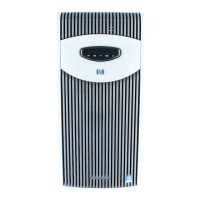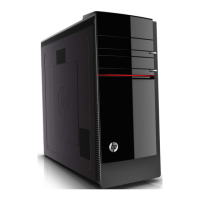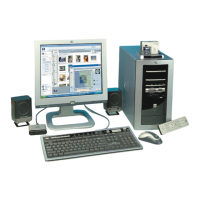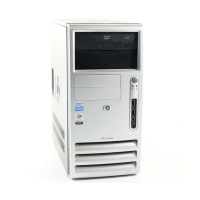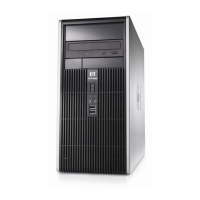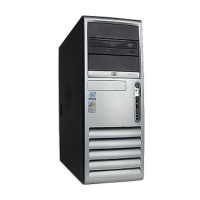Do you have a question about the HP ML370 - ProLiant - G3 and is the answer not in the manual?
Diagram and list of mechanical components of the server.
Diagram and list of internal system components.
Detailed list of mechanical and system spare parts with assembly and part numbers.
General safety precautions before servicing the server.
Procedures to prevent damage from static electricity to sensitive components.
Explanation of warning symbols found on server components.
Safety guidelines and precautions for rack-mounted servers.
Important warnings and cautions related to server operation and handling.
Steps required before performing component removal or replacement.
Instructions for extending the server from its rack mount.
Procedures for safely powering down the server before maintenance.
Steps for safely removing the server from a rack enclosure.
Guidelines for performing maintenance without powering down the server.
Procedure for removing and replacing the server's feet (tower models).
Procedure for removing and replacing the front bezel (tower models).
Procedure for removing and replacing the server's access panel.
Procedure for removing and replacing the rack bezel (rack models).
Procedure for removing and replacing the server's rack mounting rails.
Procedure for removing and replacing a power supply blanking panel.
Procedure for hot-plugging and replacing power supply units.
Procedure for removing and replacing hard drive blank covers.
Procedure for removing and replacing hot-plug SCSI hard drives.
Procedure for removing and replacing removable media bay blanks.
Procedure for removing and replacing system cooling fans.
Procedures requiring the server to be powered down.
Procedure for removing and replacing the optional redundant fan cage.
Procedure for removing and replacing the hard drive cage assembly.
Identification and description of PCI-X expansion slots.
Procedure for removing and replacing a PCI-X expansion slot cover.
Procedure for removing and replacing PCI-X expansion boards.
Procedure for removing and replacing PCI-X slot release levers.
Procedure for removing and replacing PCI-X guide clips.
Procedure for removing and replacing the processor air baffle.
Procedure for removing and replacing the server's center wall.
Procedure for removing and replacing the IDE CD-ROM drive.
Procedure for removing and replacing the power button and LED assembly.
Procedure for removing and replacing the diskette drive.
Procedure for removing and replacing the processor and heatsink assembly.
Procedure for removing and replacing the processor power module (PPM).
Information on DIMM slots and memory installation guidelines.
Procedure for removing and replacing the power supply backplane.
Procedure for removing and replacing the system board.
Procedure for removing and replacing the processor cage assembly.
Procedure for replacing the system's real-time clock battery.
Steps to re-enter the server serial number after board replacement.
Overview of software and firmware diagnostic tools for server management.
Explanation of various system LEDs indicating hardware status.
Description and function of LEDs located on the server's front panel.
Analysis of LEDs for hot-plug SCSI hard drives.
Location and status of LEDs on the RJ-45 network connectors.
Function of the rear Unit Identification (UID) LED and switch.
Status indication from hot-plug power supply LEDs.
Conditions indicated by the dual-color LED on hot-plug fans.
Identification and status of LEDs located on the system board.
Correlation between system LEDs and external health LED colors.
Combinations of system and internal health LEDs indicating server status.
Discussion of system board switches for configuration.
Function and usage of the Non-Maskable Interrupt (NMI) switch.
Purpose and settings of the system identification switch.
Function and settings of the six-position system maintenance switch.
Procedures for clearing and resetting system configuration settings.
Steps for recreating the system ROM BIOS in disaster recovery mode.
Operating and performance specifications for the tower server configuration.
Operating and performance specifications for the rack server configuration.
Specifications for supported memory modules (DIMMs).
Technical specifications for the 1.44-MB diskette drive.
Technical specifications for the CD-ROM drive.
Specifications for Wide Ultra3 hot-plug SCSI hard drives.
Diagram and list of mechanical components of the server.
Diagram and list of internal system components.
Detailed list of mechanical and system spare parts with assembly and part numbers.
General safety precautions before servicing the server.
Procedures to prevent damage from static electricity to sensitive components.
Explanation of warning symbols found on server components.
Safety guidelines and precautions for rack-mounted servers.
Important warnings and cautions related to server operation and handling.
Steps required before performing component removal or replacement.
Instructions for extending the server from its rack mount.
Procedures for safely powering down the server before maintenance.
Steps for safely removing the server from a rack enclosure.
Guidelines for performing maintenance without powering down the server.
Procedure for removing and replacing the server's feet (tower models).
Procedure for removing and replacing the front bezel (tower models).
Procedure for removing and replacing the server's access panel.
Procedure for removing and replacing the rack bezel (rack models).
Procedure for removing and replacing the server's rack mounting rails.
Procedure for removing and replacing a power supply blanking panel.
Procedure for hot-plugging and replacing power supply units.
Procedure for removing and replacing hard drive blank covers.
Procedure for removing and replacing hot-plug SCSI hard drives.
Procedure for removing and replacing removable media bay blanks.
Procedure for removing and replacing system cooling fans.
Procedures requiring the server to be powered down.
Procedure for removing and replacing the optional redundant fan cage.
Procedure for removing and replacing the hard drive cage assembly.
Identification and description of PCI-X expansion slots.
Procedure for removing and replacing a PCI-X expansion slot cover.
Procedure for removing and replacing PCI-X expansion boards.
Procedure for removing and replacing PCI-X slot release levers.
Procedure for removing and replacing PCI-X guide clips.
Procedure for removing and replacing the processor air baffle.
Procedure for removing and replacing the server's center wall.
Procedure for removing and replacing the IDE CD-ROM drive.
Procedure for removing and replacing the power button and LED assembly.
Procedure for removing and replacing the diskette drive.
Procedure for removing and replacing the processor and heatsink assembly.
Procedure for removing and replacing the processor power module (PPM).
Information on DIMM slots and memory installation guidelines.
Procedure for removing and replacing the power supply backplane.
Procedure for removing and replacing the system board.
Procedure for removing and replacing the processor cage assembly.
Procedure for replacing the system's real-time clock battery.
Steps to re-enter the server serial number after board replacement.
Overview of software and firmware diagnostic tools for server management.
Explanation of various system LEDs indicating hardware status.
Description and function of LEDs located on the server's front panel.
Analysis of LEDs for hot-plug SCSI hard drives.
Location and status of LEDs on the RJ-45 network connectors.
Function of the rear Unit Identification (UID) LED and switch.
Status indication from hot-plug power supply LEDs.
Conditions indicated by the dual-color LED on hot-plug fans.
Identification and status of LEDs located on the system board.
Correlation between system LEDs and external health LED colors.
Combinations of system and internal health LEDs indicating server status.
Discussion of system board switches for configuration.
Function and usage of the Non-Maskable Interrupt (NMI) switch.
Purpose and settings of the system identification switch.
Function and settings of the six-position system maintenance switch.
Procedures for clearing and resetting system configuration settings.
Steps for recreating the system ROM BIOS in disaster recovery mode.
Operating and performance specifications for the tower server configuration.
Operating and performance specifications for the rack server configuration.
Specifications for supported memory modules (DIMMs).
Technical specifications for the 1.44-MB diskette drive.
Technical specifications for the CD-ROM drive.
Specifications for Wide Ultra3 hot-plug SCSI hard drives.
| Product Line | ProLiant |
|---|---|
| Model | ML370 G3 |
| Processor | Intel Xeon |
| RAM | Up to 12 GB |
| Storage | SCSI |
| Drive Bays | Up to 6 |
| Network | Integrated Gigabit Ethernet |
| Expansion Slots | 6 |
| Power Supply | Redundant options available |
| RAID Support | Integrated Smart Array Controller |
| Operating System | Microsoft Windows Server, Linux |
| Form Factor | 5U |
| Processor Cores | Single / Dual Core |



